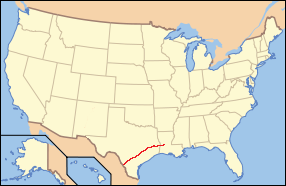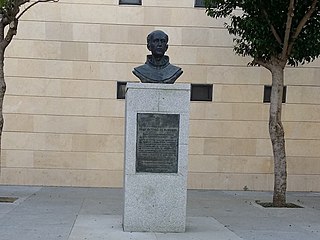Related Research Articles

Juan Bautista de Anza Bezerra Nieto was an expeditionary leader, military officer, and politician primarily in California and New Mexico under the Spanish Empire. He is credited as one of the founding fathers of Spanish California and served as an official within New Spain as Governor of the Province of New Mexico.

Maverick County is a county located in the U.S. state of Texas. As of the 2020 census, its population was 57,887. Its county seat is Eagle Pass. The county was created in 1856 and organized in 1871. It is named for Samuel Maverick, cattleman and state legislator.

Los Adaes was the capital of Tejas on the northeastern frontier of New Spain from 1729 to 1770. It included a mission, San Miguel de Cuellar de los Adaes, and a presidio, Nuestra Señora del Pilar de Los Adaes. The name Adaes represents the indigenous Adai people, who were to be served by the mission.

Spanish Texas was one of the interior provinces of the colonial Viceroyalty of New Spain from 1519 until 1821. Spain claimed ownership of the region in 1519. Slave raids by Spaniards into what became Texas began in the 16th century and created an atmosphere of antagonism with Native Americans (Indians) which would cause endless difficulties for the Spanish in the future. Spain did not attempt to establish a permanent presence until after France established the colony of Fort Saint Louis in 1685. In 1688, the French colony failed due to internal dissention and attacks by the Karankawa Indians. In 1690, responding to fear of French encroachment, Spanish explorer Alonso de León escorted several Catholic missionaries to east Texas, where they established the first mission in Texas. That attempt to establish a Spanish colony failed due to the hostility of the Caddo Indians.

The Spanish Missions in Texas comprise a series of religious outposts established by Spanish Catholic Dominicans, Jesuits, and Franciscans to spread the Catholic doctrine among area Native Americans, but with the added benefit of giving Spain a toehold in the frontier land. The missions introduced European livestock, fruits, vegetables, and industry into the Texas area. In addition to the presidio and pueblo (town), the misión was one of the three major agencies employed by the Spanish crown to extend its borders and consolidate its colonial territories. In all, twenty-six missions were maintained for different lengths of time within the future boundaries of the state of Texas.
Domingo Terán de los Ríos served as the first governor of Texas from 1691 to 1692. He also governed Coahuila, in the modern-day Mexico.
San Pedro Springs is the name of a cluster of springs in Bexar County, Texas, United States. These springs provide water for San Pedro Creek, which flows into the San Antonio River. The San Antonio Springs also feed into the San Antonio River.

The El Camino Real de los Tejas National Historic Trail is a national historic trail covering the U.S. section of El Camino Real de Los Tejas, a thoroughfare from the 18th-century Spanish colonial era in Spanish Texas, instrumental in the settlement, development, and history of Texas. The National Park Service designated El Camino Real de los Tejas National Historic Trail as a unit in the National Trails System in 2004.

The New Philippines was the abbreviated name of a territory in New Spain. Its full and official name was Nuevo Reino de Filipinas.

Antonio Margil, OFM was a Spanish Franciscan missionary in North and Central America. Based at the College of Santa Cruz in Santiago de Querétaro, after 1715, he worked largely in Texas and Louisiana. Father Margil was declared "Venerable" in 1836.
Martín de Alarcón was the Governor of Coahuila and Spanish Texas from 1705 until 1708, and again from 1716 until 1719. He founded San Antonio, the first Spanish civilian settlement in Texas.

The City of San Antonio is one of the oldest Spanish settlements in Texas and was, for decades, its largest city. Before Spanish colonization, the site was occupied for thousands of years by varying cultures of indigenous peoples. The historic Payaya Indians were likely those who encountered the first Europeans.

Antonio de San Buenaventura y Olivares or simply Fray Antonio de Olivares was a Spanish Franciscan who officiated at the first Catholic Mass celebrated in Texas, and he was known for contributing to the founding of San Antonio and to the prior exploration of the area. He founded, among other missions, the Alamo Mission in San Antonio, the Presidio San Antonio de Bexar, and the Acequia Madre de Valero.
Luis de Moscoso Alvarado (1505–1551) was a Spanish explorer and conquistador. Luis de Moscoso Alvarado assumed command of Hernando De Soto's expedition upon the latter's death.
Isidro Félix de Espinosa (1679–1755) was a Franciscan missionary from New Spain who participated in several expeditionary missions throughout the province of Tejas. He was the president of the missionaries from the College of Santa Cruz de Querétaro.
Juan Galván (?–?) was a Spanish soldier and explorer who served as an ensign and explorer in San Antonio, Texas. It was on his recommendation that the Presidio San Saba was established.

Presidio de Béxar was a Spanish fort built near the San Antonio River, located in what is now San Antonio, Texas, in the United States. It was designed for protection of the mission San Antonio de Valero and the Villa de Béjar. The Presidio de Béxar was founded on May 5, 1718 by Spanish colonial official Martín de Alarcón and his party of thirty-five soldiers. The Villa de Béjar is known for being the first Spanish settlement of San Antonio and consisted of the families of the Presidio Soldiers and those of the prior expeditions. It also served to secure Spain's claim to the region against possible encroachment from other European powers.

Yanaguana was the Payaya people village in the geographical area that became the Bexar County city of San Antonio, in the U.S. state of Texas. Some accounts believe the Payaya also referred to the San Antonio River as Yanaguana, and it is sometimes promoted as such for the tourist industry. For a number of years, the city of San Antonio contracted with Yanaguana Cruises Inc. for an exclusive monopoly to operate tour barges on a select section of the river. The National Park Service has a designated "Yanaguana Trail" that runs along the river at Mission San Juan Capistrano. In 1933 Frederick C. Chabot of San Antonio formed the Yanaguana Society, specifically named for the Payaya village, to collect and preserve the early artifacts and history of the area. The organization lasted through 1960.
The Pastia people were a hunter-gatherer tribe of the Coahuiltecan. The Pastias inhabited the area south of San Antonio, largely between the Medina and San Antonio Rivers and the southward bend of the Nueces River running through modern day La Salle and McMullen counties. They were first contacted by Spanish explorers in the early eighteenth century, and were extinct as an ethnic group by the middle of the following century.
José Domingo Ramón was a Spanish military man and explorer who founded several missions and a presidio in East Texas to prevent French expansion in the area.
References
- 1 2 3 4 5 6 Johnson, John G. (2010). "AGUIRRE, PEDRO DE". Handbook online of Texas.
- 1 2 Helen Simons; Cathryn A. Hoyt (1996). A Guide to Hispanic Texas. University of Texas Press, Austin. p. 180. ISBN 978-0-292-77709-5.
- 1 2 J. C. Edmondson (2000). Alamo Story: From Early History to Current Conflicts. Republic of Texas Press. p. 8. ISBN 978-0-585-24106-7.
- 1 2 3 4 5 Donald E. Chipman. "Isidro de Espinoza". Handbook of Texas Online. Retrieved May 8, 2010.
- ↑ Juliana Barr (2007). "Peace Came in the Form of a Woman". Chapel Hill: University of North Carolina Press. pp. 33–34, 46.